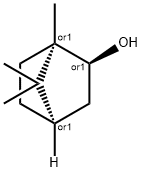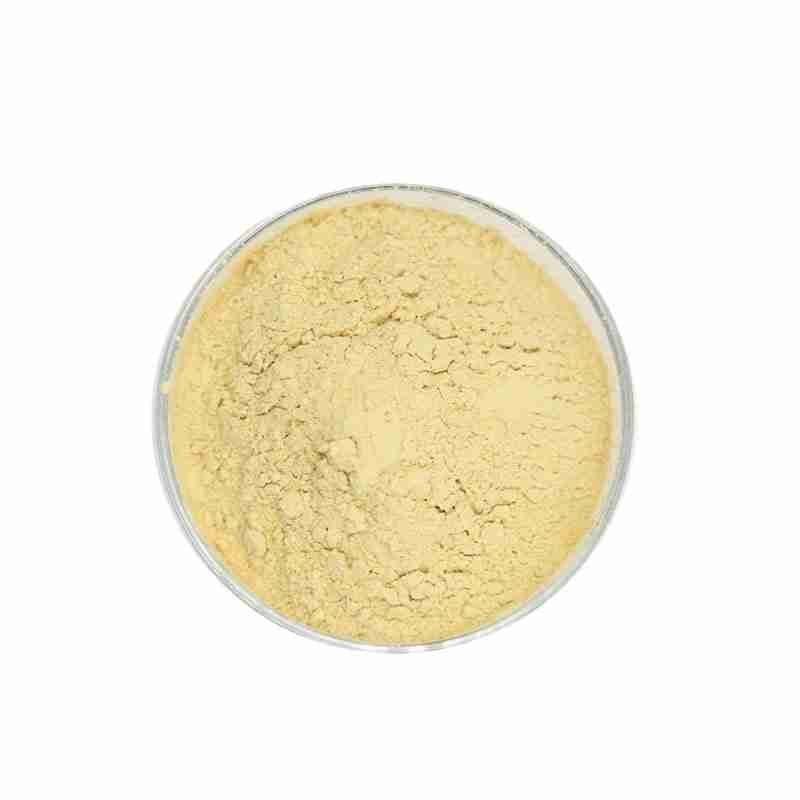Borneol CAS# 507-70-0
Borneol, other names: dipterocarp, brain, pellets, plum blossom brain, natural borneol, old plum slices, plum slices. Main ingredients: This product is a crystal obtained from the resin and volatile oil of dipterocarps. It is almost pure dextrorotary borneol. The resin and volatile oil of Dipterocarps contain a variety of terpenes. In addition to borneol, it also contains sesquiterpenes such as humulene, ??-elemene, and caryophyllene, as well as oleanolic acid, malic acid, asiatic acid, borneol ketone, borneol diol ketone, and archaic acid. Triterpene compounds such as codiol.
发送询盘
Borneol CAS# 507-70-0
| Borneol Basic information |
| Description?References |
| Product Name: | Borneol |
| Synonyms: | (1R,2S,4R)-rel-1,7,7-TriMethylbicyclo[2.2.1]heptan-2-ol;Endo-1,7,7-trimethyl-bicyclo[2.2.1]heptan-2-ol 2-Camphanol;1,7,7-Trimethyl-bicyclo(2.2.1)heptan-2-ol, endo-;1,7,7-trimethyl-endo-Bicyclo[2.2.1]heptan-2-ol;2-Bornanol, endo-;L-BORNEO CAMPHOR;L-BORNYL ALCOHOL;L-2-HYDROXYBORNANE |
| CAS: | 507-70-0 |
| MF: | C10H18O |
| MW: | 154.25 |
| EINECS: | 208-080-0 |
| Product Categories: | standardized herbal extract;Inhibitors;Monoterpenoids;Biochemistry;Terpenes;Alcohols;C9 to C30;Oxygen Compounds;Bicyclic Monoterpenes;chemical reagent;pharmaceutical intermediate;phytochemical;reference standards from Chinese medicinal herbs (TCM).;Pharmaceutical;Intermediate |
| Mol File: | 507-70-0.mol |
 |
|
| Borneol Chemical Properties |
| Melting point | 206-209???C |
| Boiling point | 210???C(lit.) |
| alpha | -0.5??+0.5?b(20??/D)(c=5,C2H5OH) |
| density | 1.011 |
| vapor density | 5.31 (vs air) |
| vapor pressure | 33.5 mm Hg ( 25 ??C) |
| refractive index | 1.4831 (estimate) |
| FEMA | 2157 | BORNEOL |
| Fp | 150???F |
| solubility | DMSO:30.0(Max Conc. mg/mL);194.49(Max Conc. mM) Ethanol:30.0(Max Conc. mg/mL);194.49(Max Conc. mM) |
| form | powder to crystal |
| pka | 15.36??0.60(Predicted) |
| color | White to Almost white |
| Odor | at 10.00 % in dipropylene glycol. pine woody camphor balsamic |
| Odor Type | balsamic |
| Water Solubility | insoluble |
| JECFA Number | 1385 |
| Merck | 14,1338 |
| Stability: | Stable. Highly flammable. Incompatible with strong oxidizing agents. |
| InChIKey | DTGKSKDOIYIVQL-WEDXCCLWSA-N |
| LogP | 3.6 at 20?? |
| CAS DataBase Reference | 507-70-0(CAS DataBase Reference) |
| NIST Chemistry Reference | Borneol(507-70-0) |
| EPA Substance Registry System | Borneol (507-70-0) |
- 2
- 2-diallylpent-4-en-1-amine
- 4
- 95-16-9
- Ammonium sulfamate
- Benzothiazole
- cas:67889-00-3ح2
- cas:83524-75-8 | pigment black 32
- cas:928836-00-4 | 2
- cas:932745-70-5 | 4
- Chemical Minerals
- Coconut diethanolamide
- Daily Chemicals
- discount
- for sale
- General pvc resin
- hexyl D-glucoside
- in stock
- Lauramidopropyl betaine
- LAURIC ACID MONOETHANOLAMIDE
- Petroleum Additives
- Plasticiser
- Ploymers
- price
- PVC
- quotation
- Raw Materal
- Remove term: Petroleum Additives Petroleum Additive
- SODIUM ETHYL 2-SULFOLAURATE
Related Products
Common English name: 5-iodo-2,3-dihydropyridazin-3-one
CAS No.: 825633-94-1
Molecular formula: C4H3IN2O
Molecular weight: 221.98
Sample: Available
Chemical Name: Ashwagandha Extract
Synonyms: Withania somnifera, ext.; Withania Somnefera Extract
CAS: 90147-43-6
Appearance: Brown
Chemical Name: Imazalil Sulfate
CAS No.: 58594-72-2
Molecular Formula: C14H14Cl2N2O.H2SO4
Molecular Weight: 395.26
Appearance: Solid
Product name:Cyclopentane
Purity:96%
Appearance:White powder
Package:25kg/bag
Sample:Available
Product name:HYDROXYPROPYL GUAR HYDROXYPROPYLTRIMONIUM CHLORIDE
Purity:99%
Appearance:Light Yellow Powder
Package:Customized according to customer needs.
Sample:Available
Chemical Name: Zinc citrate
Synonyms: Zinc citrate trihydrate
CAS No.: 546-46-3
Molecular Formula: C6H8O7Zn
Molecular Weight: 257.5
Appearance: White powder
3,4-Ethylenedioxythiophene is a synthetic organic compound characterized by its unique structure that includes a thiophene ring with ethylenedioxy substituents at the 3 and 4 positions. This compound is known for its potential applications in the synthesis of various organic materials, including pharmaceuticals and organic electronic devices such as sensors and solar cells. Its stability and reactivity make it a versatile intermediate in the chemical industry.
Octocrylene is an organic compound widely recognized for its potent UV-filtering properties, making it an essential ingredient in sunscreens and other skincare products designed to protect the skin from harmful ultraviolet radiation. With the chemical name 2-(4-Methylbenzyl)-2H-benzotriazole-5-methyl, octocrylene is a stable and photostable molecule that provides broad-spectrum protection against both UVA and UVB rays.
This oil-soluble chemical is valued for its ability to absorb UV radiation effectively, converting it into heat without causing skin irritation or staining clothes. Octocrylene is often used in combination with other UV filters to enhance the sun protection factor (SPF) of formulations, ensuring a balanced and comprehensive defense against sun damage.
As a lipophilic compound, octocrylene is compatible with various cosmetic and dermatological formulations, contributing to the development of lightweight, non-greasy sunscreens. Its chemical structure allows for a high degree of safety and efficacy, making it suitable for a wide range of skin types, including sensitive skin.
In summary, octocrylene is a reliable and efficient UV filter, pivotal in the formulation of modern sunscreens that offer advanced protection against the sun’s harmful effects while maintaining skin comfort and product aesthetics.
N,N-Dimethylaniline is an organic compound with amine and methyl groups attached to a benzene ring. It is a colorless liquid with a characteristic amine odor. This compound is primarily used as a chemical intermediate in the synthesis of dyes, pigments, and polymers. Its reactivity makes it a valuable building block in the production of various organic compounds, particularly in the pharmaceutical and chemical industries.
Chemical Name: o-Xylene
Synonyms: 1,2-Dimethylbenzene; ortho-xylene
CAS No.: 95-47-6
Molecular Formula: C8H10
Molecular Weight: 106.17
Butylated Hydroxytoluene (BHT) is a synthetic phenolic antioxidant commonly added to foods, cosmetics, and packaging to prevent the oxidation of fats and oils, thereby extending their shelf life. It is also used as a preservative in a variety of products, including rubber, petroleum products, and animal feed. BHT is recognized for its effectiveness in maintaining nutrient levels, color, flavor, and odor in food products . It is known to have a melting point of 69-71??C, a boiling point of 265??C, and is soluble in ethanol, acetone, and benzene, but not in water, glycerin, or propylene glycol . BHT is also used in some dietary supplements due to its antioxidant properties . However, it is important to handle BHT with care, as it can cause skin irritation and is considered harmful if swallowed .
Chemical Name: Choline salicylate
CAS No.: 2016-36-6
Molecular Formula: C12H19NO4
Molecular Weight: 241.28
Appearance: Red-Brown Crystal



















